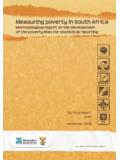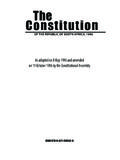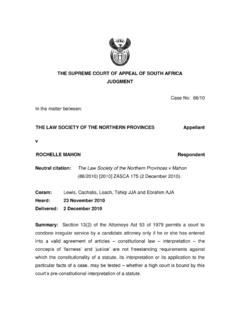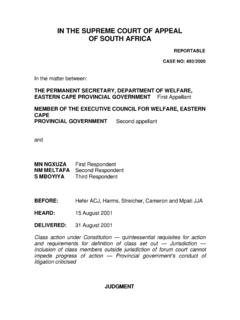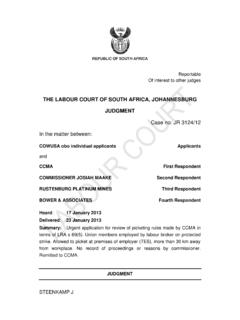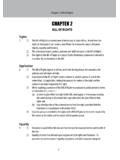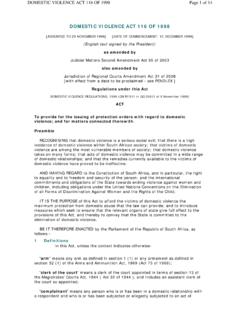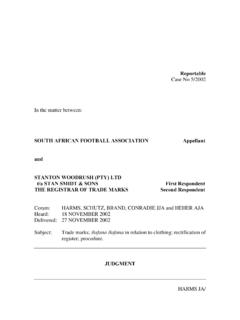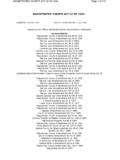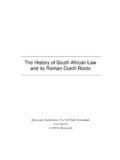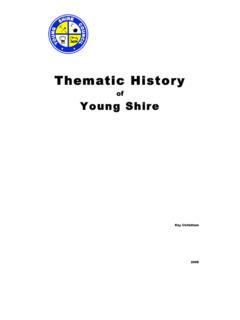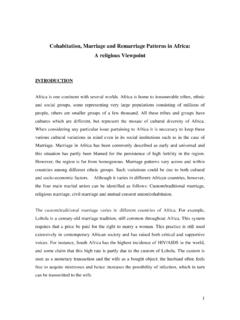Transcription of REPUBLIC OF SOUTH AFRICA - justice.gov.za
1 REPUBLIC OF SOUTH AFRICA THE SUPREME COURT OF APPEAL OF SOUTH AFRICA Case number: 332/04 Reportable In the matter between: ROAD ACCIDENT FUND APPELLANT and MXOLISI RICHARD MTATI obo ZUKHANYE MTATI RESPONDENT CORAM: MPATI DP, ZULMAN, FARLAM, VAN HEERDEN et JAFTA JJA HEARD: 17 MAY 2005 DELIVERED: 1 JUNE 2005 SUMMARY: Delict pregnant woman injured in motor collision child subsequently born with brain damage resulting from collision whether child has action against RAF. _____ JUDGMENT _____ FARLAM JA 2 INTRODUCTION [1] This is an appeal against the dismissal by Froneman J, sitting in the East London Circuit Local Division of the High Court, of a special plea raised by the appellant against a claim brought by the respondent, in his capacity as father and natural guardian of his minor daughter, Zukhanye Mtati, in terms of Article 40 of the Agreement set out in the schedule to the Multilateral Motor Vehicle Accidents Fund Act, 93 of 1989.
2 (References in what follows to the Act are references to Act 93 of 1989.) PLEADINGS [2] In his particulars of claim the respondent claimed an amount of R1 365 580 from the appellant, alleging that a collision took place on 20 December 1989 in East London between a motor vehicle, which was being negligently driven at the time by one Dlalo, and the respondent s wife, who was a pedestrian. As a result of the collision it was alleged, the respondent s wife, who was then pregnant with Zukhanye, sustained serious bodily injuries. Zukhanye was born some five and a half months after the collision. It is alleged in the particulars of claim that she has brain damage and is mentally retarded and that this brain damage and mental retardation arose out of the injuries sustained by her mother as a result of the collision. 3[3] The appellant s special plea rests on two bases.
3 [4] The first is what is contended to be the proper construction of Article 40 of the Agreement, which reads as follows: The MMF [ie, the Multilateral Motor Vehicle Accidents Fund, the predecessor of the appellant] or its appointed agent, as the case may be, shall subject to the provisions of this Agreement, be obliged to compensate any person whomsoever (in this Agreement called the third party) for any loss or damage which the third party has suffered as a result of (a) any bodily injury to himself; (b) the death of or any bodily injury to any person, in either case caused by or arising out of the driving of a motor vehicle by any person whomsoever at any place within the area of jurisdiction of the Members of the MMF, if the injury or death is due to the negligence or other unlawful act of the person who drove the motor vehicle (in this Agreement called the driver) or of the owner of the motor vehicle or his servant in the execution of his duty.
4 The appellant contends in its special plea that, as the respondent s minor child was at the time of the collision a foetus in utero, she was not, on what is called a proper construction of Article 40, a person entitled to compensation. [5] The second basis for the special plea is an averment that a foetus in utero is not in law regarded as a person and in the circumstances the insured driver cannot be said to have owed a duty of care to ZUKHANYE. 4 EARLIER DECISION ON ISSUE RAISED IN THIS CASE [6] Some of the legal issues which arise in this case came before this court for decision in August 1963 when an appeal from the judgment of Hiemstra J in Pinchin and Another NO v Santam Insurance Co Ltd 1963 (2) SA 254 (W) was argued. This court was satisfied that Hiemstra J had correctly decided that the plaintiffs in the case before him had not succeeded in proving that the injuries which the mother sustained in the collision which gave rise to that case had caused cerebral palsy from which her child born subsequent to the collision was suffering.
5 It was thus unnecessary for this court to decide whether Hiemstra J was right in holding that a child has an action in our law to recover damages for pre-natal injuries. See Pinchin and Another NO v Santam Insurance Co Ltd 1963 (4) SA 666 (A). Hiemstra J s judgment in Pinchin s case has been quoted with approval in judgments in Australia (see Watt v Rama [1972] VR 353 (FC), a decision of the Supreme Court of Victoria, at 360), and in England (see Burton v Islington Health Authority; de Martell v Merton and Sutton Health Authority [1992] 3 All ER 833 (CA) at 840f-g). It has also been discussed in leading textbooks published in Australia (see Fleming The Law of Torts 9 ed p 182) and England (see Charlesworth and Percy on Negligence 10 ed p 88). Most of the legal review articles in which it 5has been discussed are listed in what amounts to a monograph on the legal issues arising for decision in this case, published as a footnote (footnote 15 on pp 33 to 38, presumably the longest footnote in SOUTH African legal history) in Boberg s Law of Persons and the Family 2 ed.
6 In an earlier footnote (footnote 12 at pp 32-33) it is pointed out that the problem arising for consideration in this case is an international one and reference is made to the vast literature on this vexing subject . Two contributions are singled out for particular mention, the article by Sir Percy Winfield The Unborn Child published in (1942) 8 Cambridge LJ 76 and the dissertation by David A Gordon SC The Unborn Plaintiff published in (1965) 12 J of Forensic Medicine 111 and 152, (1966) 13 J of Forensic Medicine 23 (an abridged version of this dissertation, published in (1965) 63 Mich L Rev 579, was cited in Watt v Rama supra at 358). To the extensive list of writings on the topic listed in the second edition of Boberg I wish merely to add references to articles by PA Lovell and RH Griffith-Jones (1974) 90 LQR 531 and Professor Peter F Cane (1977) 51 Australian LJ 704; the doctoral dissertations by PC Smit Die Posisie van die Ongeborene in die Suid Afrikaanse Reg met Besondere Aandag aan die Nasciturus-Leerstuk (1976, University of the Orange Free State) and PJJ Olivier Legal Fictions: an Analysis and Evaluation (1973, 6 University of Leiden) pp 119-123 and 153-4; the translated materials collected and annotated by Sir Basil Markesinis in A Comparative Introduction to the German Law of Torts 3 ed pp 39-40 and 130-142, and the annotation on Liability for Pre-Natal Injuries published in 40 ALR 3ed pp 1222 et seq.
7 [7] In concluding that a child has an action for injuries sustained while a foetus, Hiemstra J applied the so-called nasciturus fiction derived from Roman law to the effect that an unborn child, if subsequently born alive, is considered as already in existence whenever its own advantage is concerned (see, eg, Digest ), holding that this rule not only applied to questions of succession and status but could also be extended to the law of delict. In coming to this conclusion he strongly relied inter alia on Montreal Tramways Co v L veill (1933) 4 DLR 337 (SCC), a decision of the Supreme Court of Canada in an appeal from Quebec, and the article by Sir Percy Winfield to which I have already referred. [8] The ratio of his judgment on the point presently at issue appears at 260 A-C, as follows: I hold that a child does have an action to recover damages for pre-natal injuries.
8 This rule is based on the rule of the Roman law, received into our law, that an unborn child, if subsequently born alive, is deemed to have all the rights of a born child, whenever this is to its advantage. There is apparently no 7reason to limit this rule to the law of property and to exclude it from the law of delict. [9] The Pinchin case was an action brought under s 11 of the Motor Vehicle Insurance Act 29 of 1942 which, as far as was material, provided that a registered insurance company (such as the defendant in that case) had to compensate any person whatsoever (in this section called the third party) for any loss or damage which the third party has suffered as a result of (a) any bodily injury to himself; (b) the death of or any bodily injury to any person, in either case caused by or arising out of the driving of the insured vehicle .. (As can be seen this section was in pari materia with Article 40 of the MMF Agreement.)
9 [10] Having pointed out (at 256A) that the word person was not defined, Hiemstra J said that it had therefore to bear its ordinary common law meaning . He continued: Whether the foetus is a person or not, seems to me to be irrelevant if the legal fiction applies that it is to be regarded as if it is already born whenever this should be to its advantage. He accordingly held that the plaintiff s minor son had an action under s 11 of Act 29 of 1942. 8 JUDGMENT IN COURT A QUO [11] In his judgment in the court a quo Froneman J accepted that the Pinchin decision was correct and that, as he put it: .. the Act and the common law must therefore be approached in the context of the qualified principle set out above, namely to regard, when appropriate, a foetus as a person when upon birth it is to his or her advantage. The real and difficult question is to determine when the circumstances are appropriate and when they are not.
10 [12] The learned judge held that it was appropriate to apply the nasciturus rule in this case. Among the factors which led him to this conclusion was the fact that Act 93 of 1989 was .. social legislation aimed at the widest possible protection and compensation against loss and damages for the negligent driving of a motor vehicle (compare SA Eagle Insurance Co Ltd v Pretorius 1998 (2) 656 (SCA), 659I-660D). To a large extent it represents .. an embodiment of the common law actions relating to damages for bodily injury and loss of support caused by or arising from the negligent driving of a motor vehicle (Evins v Shield Insurance Co Ltd [1980 (2) SA 814 (A)], 841E). [13] He held that a duty of care could be owed to a foetus and that there was no substance in the argument raised on behalf of the present appellant that a finding on this point in favour of the respondent would, to use the familiar clich , open the flood gates of litigation.
